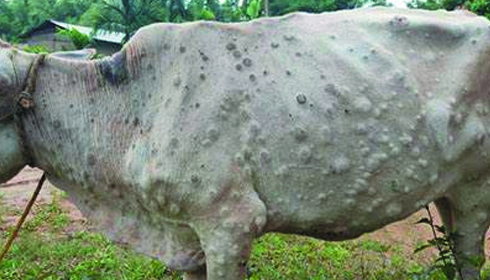
Lumpy Skin Disease Outbreak Threatens Indian Cattle and Economy: IISc Research
A mysterious and devastating outbreak of lumpy skin disease among cattle in India has sparked grave concerns about its impact on both human health and the nation's economy. Since May 2022, approximately 100,000 cows have succumbed to this illness, leading to profound losses in the agricultural sector.
Professor Utpal Tatu, from the Indian Institute of Science (IISc), describes the situation as a "national emergency," prompting a collaborative effort among various institutions to investigate the cause of the outbreak. Their findings, published in BMC Genomics, shed light on the evolution and origins of the virus strains responsible for the crisis.
Lumpy skin disease, caused by the Lumpy Skin Disease Virus (LSDV), is transmitted by insects such as flies and mosquitoes. The disease manifests with symptoms including fever and skin nodules, often proving fatal for cattle. While LSDV was initially identified in Zambia in 1931, its spread was limited to Sub-Saharan Africa until 1989. However, it has since expanded its reach to the Middle East, Russia, and now South Asia.
The research team, in collaboration with veterinary institutes, collected samples from infected cattle in states including Gujarat, Maharashtra, Rajasthan, and Karnataka. Advanced whole-genome sequencing of DNA extracted from these samples revealed two distinct LSDV variants circulating in India. One variant exhibited a low number of genetic variations, resembling strains previously identified in Ranchi and Hyderabad. Conversely, the other variant displayed a high number of genetic variations, akin to strains observed during an outbreak in Russia in 2015.
Lumpy Skin Disease Virus (LSDV) mostly affects cattle and is not thought to infect humans. It is classified as a zoonotic illness, which means it is primarily spread from animals to humans. However, there is currently no proof that LSDV can spread from cattle to people. The virus is transmitted by insect vectors such as flies and mosquitoes, which help spread the disease across cow populations. As a result, the risk of LSDV transmitting from cattle to people is exceedingly low. Nonetheless, it is critical to maintain proper hygiene practices and take the required precautions while handling diseased animals in order to reduce any potential hazards.
Ankeet Kumar, a PhD student at IISc and co-lead author of the study, highlights the unexpected discovery of numerous genetic variations in the Indian strains. Such variations, particularly in genes crucial for viral function, may contribute to the severity of the disease. Kumar suggests that the diversity in strains could enhance the virus's virulence, leading to more severe symptoms in affected cattle.
The implications of this research published in the journal, BMC Genomics recently, extend beyond mere understanding; they offer avenues for improved diagnostics, vaccines, and interventions against emerging infectious diseases affecting livestock. Tatu emphasises the significance of this genomic data in guiding vaccine development efforts by identifying molecular targets and genetic variations.
This collaborative effort underscores the importance of the One Health approach, which integrates expertise from diverse disciplines to address pressing public health challenges. Tatu acknowledges the invaluable contributions of veterinary doctors in understanding the disease's epidemiology and emphasises the critical role of interdisciplinary collaboration in tackling such crises.
As India grapples with the ramifications of the lumpy skin disease outbreak, the insights gleaned from this research may prove instrumental in mitigating its impact on both cattle welfare and the nation's economy.